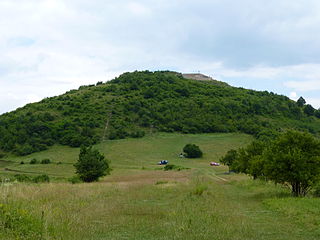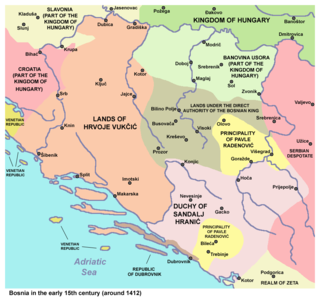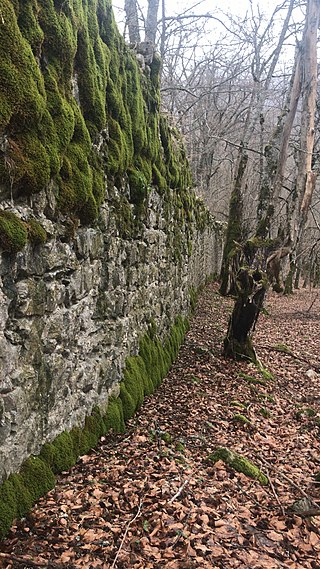List
The list is based on body of work in Bosnia and Herzegovinian historiography. [1] [2] [3] [4] [5]
This is a list of fortifications in Bosnia and Herzegovina , including fortresses and castles, arranged alphabetically.
Bosnian archaeologist and historian of the Middle Ages, Pavao Anđelić, posited that Bosnia and Herzegovina is a home of great number of forts, fortresses, castles, including a number of walled city-fortresses, in various degrees of preservation, and built in different stages of Bosnian history. According to his research he argued that at least 350 of these edifices exists on the territory of modern-day Bosnia and Herzegovina, [1] most of which was erected by or belonged to a medieval Bosnian state, while small number in its borderlands simply rests on the territories included into modern state of Bosnia and Herzegovina, which was largely unchanged, with few very minor exceptions, since 1878. In his book, the Medieval Towns in Bosnia and Herzegovina, historian of architecture of the Middle Ages in Bosnia and Herzegovina, Husref Redžić, described 225 sites in manuscript and 147 in published book. [1]
The list is based on body of work in Bosnia and Herzegovinian historiography. [1] [2] [3] [4] [5]

Visoko is a city located in the Zenica-Doboj Canton of the Federation of Bosnia and Herzegovina, an entity of Bosnia and Herzegovina. As of 2013, the municipality had a population of 39,938 inhabitants with 11,205 living in Visoko town. Located between Zenica and Sarajevo, Visoko lies where the river Fojnica joins the Bosna.

Podvisoki was a medieval settlement, a castle town, as part of wider area just beneath of the fortress Visoki, located on the Visočica hill above modern-day Visoko, Bosnia and Herzegovina.

Srebrenik Fortress is a fortress located near the city of Srebrenik in Bosnia and Herzegovina. It has been a national monument of Bosnia and Herzegovina since 2 November 2004.

Vrnograč Castle is a castle in Bosnia and Herzegovina, built during the Middle Ages on the territory of the municipality of Velika Kladuša.

The House of Pavlović, also Radinović or Radenović, or Radinović-Pavlović, was Bosnian noble family who got their name after Radin Jablanić. Radin's father, Jablan, was a founder of Jablanić house, an earlier branch of this medieval Bosnian clan. Jablan's estate was in Jablan village. Later, family extended their feudal possessions from the Middle and Upper Drina river in the eastern parts of medieval Bosnia, known as Pavlovića zemlja, to south-southeastern regions of the Bosnian realm in Hum and Konavle at the Adriatic coast. The family official residence and seat was at Borač and later Pavlovac, above the Prača river canyon, between present-day Prača, Rogatica and Goražde in Bosnia and Herzegovina.
Tođevac is a village in the municipality of Foča, Republika Srpska, Bosnia and Herzegovina. Fortress Tođevac is located here.

The Ostrovica Castle is a large medieval structure situated above the small village of Ostrovica near Kulen Vakuf, Bihać municipality, Bosnia and Herzegovina. Having been built on a heavily wooded ridge of a steep hill overlooking left bank of the shallow Una river, the castle was located on a strategic site connecting the northern and southern parts of the long Una valley.

The Borač Castle was a noble court and one of the largest and most important fortified towns of medieval Bosnia, situated on top of rugged slopes high above the Prača river canyon, between Mesići and Brčigovo, near modern-day Rogatica, in Bosnia and Herzegovina. The fortified castle was a seat of the Pavlović noble family.

Drina was a medieval župa (parish), and later zemlja, located in what is now Podrinje, the region in the Drina river valley, shared by (eastern) Bosnia and Herzegovina and (western) Serbia. Its location and spreading is unclear, although assumed to be located in middle and upper course of the river Drina, on its left bank in Bosnia and Herzegovina. Podrinje was part of the first Serbian principality, in the Early Middle Ages. John Kinnamos (1143–1185) noted that the river Drina separated Bosnia from Serbia, while one Papal document from 1187 erroneously identified Bosnia as part of Serbia. Early medieval Bosnian state included regions on the left bank of the Drina, where the župa was located. Bosnian noble family of Pavlović ruled the region, along with other feudal possessions that extended from the middle and Upper Drina river to the south-southeastern regions of the Bosnian realm in Hum and Konavle at the Adriatic coast. The family official residence and seat was at Borač and later Pavlovac, above the Prača river canyon, between present-day Prača, Rogatica and Goražde. Also, it was part of the dominion of the Kosača noble family, while another lesser Bosnian noble family had their possessions in the region, namely Dinjčić noble family's.

The Pavlovac Castle was a noble court and one of the largest and most important fortified towns of medieval Bosnia, situated on top of rugged slopes high above the Prača river canyon, near modern days Prača village, in Bosnia and Herzegovina. The fortified castle was a seat of the medieval Bosnian noble family Radinović-Pavlović.

Pavao Anđelić (1920-1985) was a Bosnian Croat and Yugoslav lawyer, archaeologist and historian. He mainly studied the history of medieval Bosnia and is noted for archeological work done at Mile and historically rich areal surrounding modern town of Visoko, as well as Kraljeva Sutjeska and Bobovac.

Travnik Castle, locally known as Stari Grad Castle, is a medieval town-fortress complex in the town of Travnik, Central Bosnia Canton, Bosnia and Herzegovina.

Ključ fortrass, locally known as Stari grad Ključ, is a medieval castle complex in the village of Ključ, Gacko, Bosnia and Herzegovina. The historic area includes the Ključ fortress, the Podključ castle town as part of a wider area just beneath of the fortress, the Ključ Mosque with a harem. The site has been declared a National monument of Bosnia and Herzegovina by the Commission to preserve national monuments of Bosnia and Herzegovina.
Kozograd or Old town of Kozograd is the name of a medieval fortress whose remains are located in the municipality of Fojnica, Bosnia and Herzegovina. It is an archeological site of significant historical value. Although it is one of the least explored fortresses in Bosnia and Herzegovina, it is known that in 1444 it temporarily housed the official chancery of King Tomaš, and that in 1463, after the arrival of the Ottomans, the Bosnian queen Katarina stayed there before moving on to Rome. It was declared a National Monument of Bosnia and Herzegovina at a session held from November 4 to 6, 2015. The National Monument is an unexplored archeological site and consists of the remains of medieval ramparts, towers, wells and ditches in the southern portion of the fortress.

Ključ Fortress is a medieval fortress in Bosnia and Herzegovina, above the modern-day town of Ključ. It is located on an elongated slope on high rocks that dominate the valley of the river Sana. Before it was redeveloped, there was a small ancient fortress from Roman times.
The Kamengrad Fort is a medieval ruin located on a plateau above the settlement of Donji Kamengrad, Bosnia and Herzegovina.

Ljubuški Fortress, also known as Herceg Stjepan's Fortress, or the Old town of Ljubuški, is a medieval fortress in the municipality of Ljubuški, Bosnia and Herzegovina.

The Borak necropolis with stećaks is located in Bosnia and Herzegovina on the hill of Borak, next to the village of Burati, at an altitude of 140m. To the right of the main road Sokolac-Rogatica. The national monument is located in the location that includes Kramer village, Rogatica municipality. 212 visible stećaks were recorded at the necropolis, of which the greater number are oriented in the east–west direction, and the smaller number are in the north–south direction.
Husref Redžić was a Bosnian architect, historian of architecture, specifically Islamic and medieval art and Islamic and medieval architecture of Bosnia and Herzegovina and Yugoslavia.
Kušlat, also Kučlat, is medieval fortress in Bosnia and Herzegovina. The fortress is located south of Zvornik, not far from Paljević, above the confluence of the Jadar and Drinjača, in Zvornik municipality. The fortress had its own podgrađe, with a trg or trgovište, and was called Podkučlat. Podkučlat also had a medieval custom for collecting taxes from merchants who traded goods in the region.